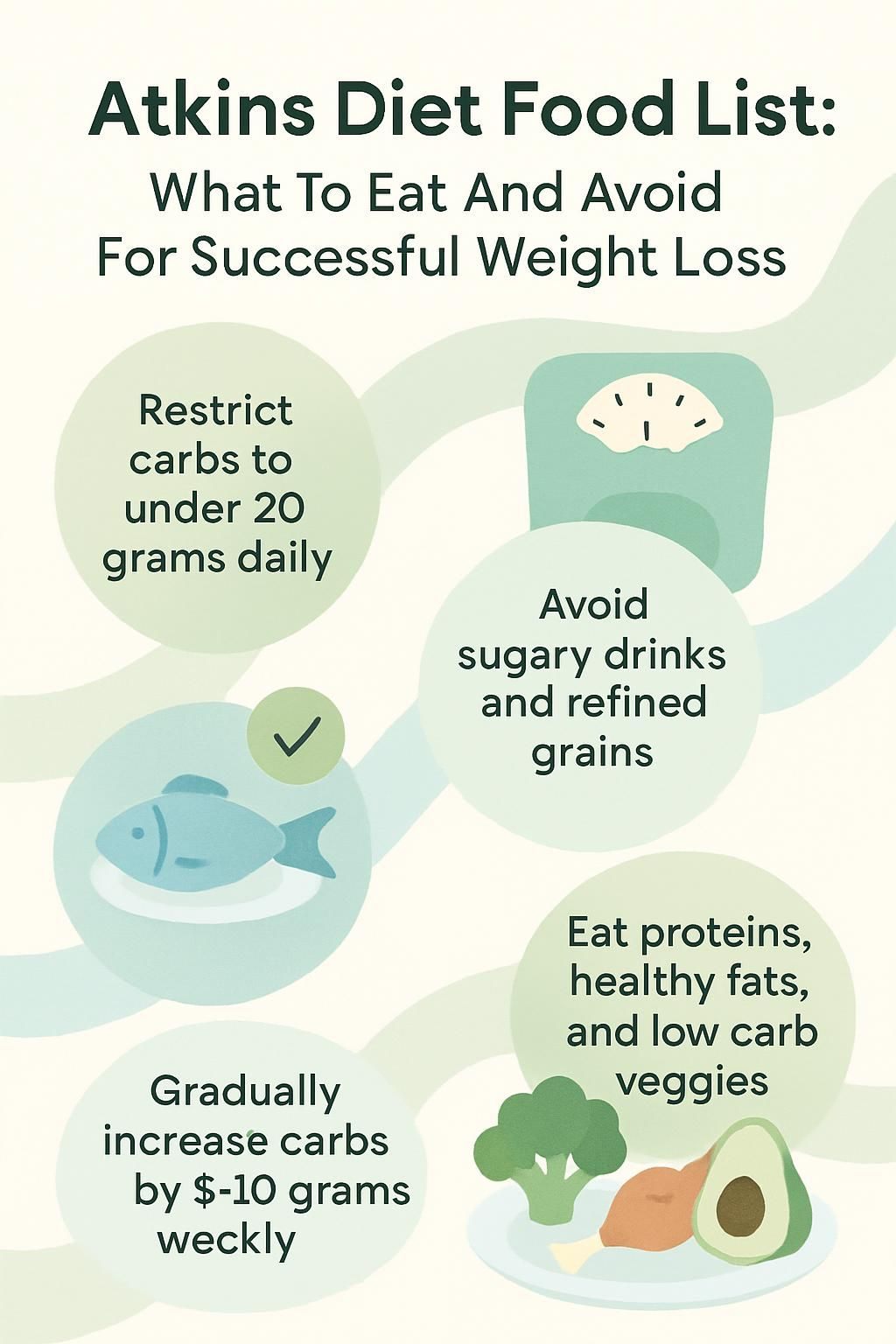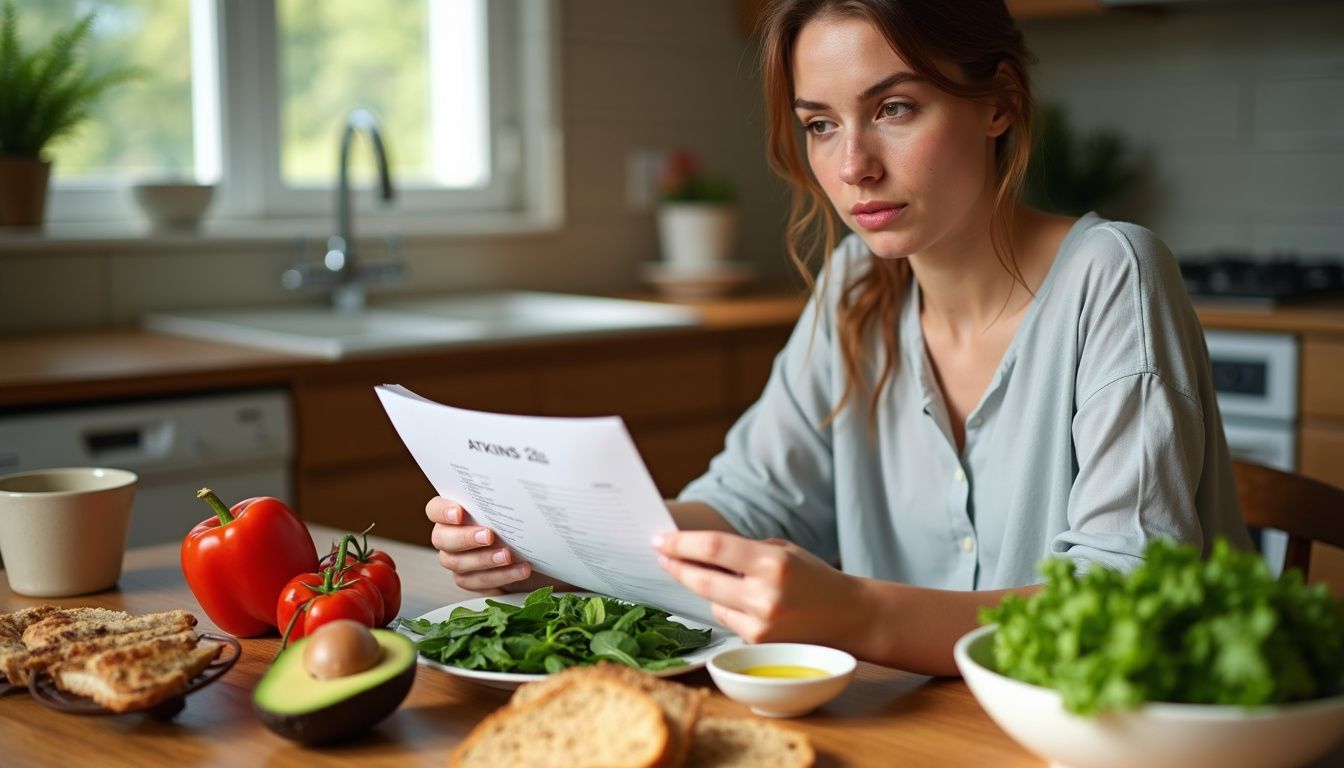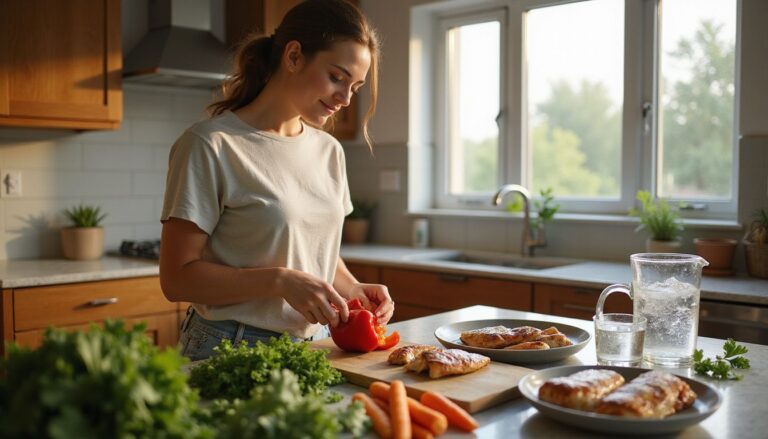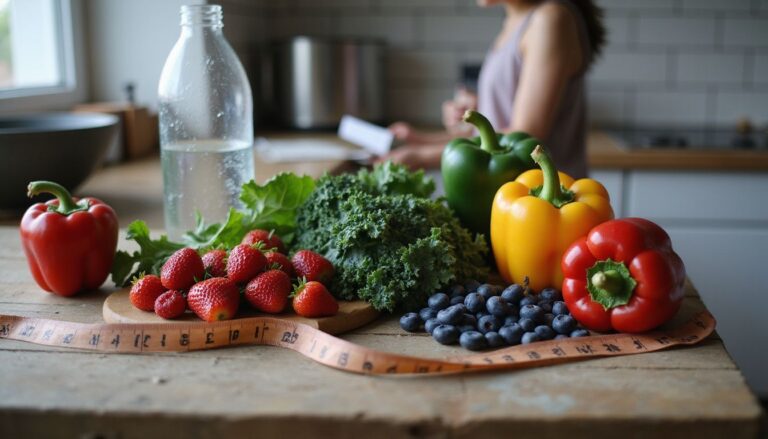Atkins Diet Food List: What To Eat And Avoid For Successful Weight Loss
Our Nutrition Assistant AI Suite will transform your body. You will lose fat, get toned, and build muscle. Gain confidence and optimal health.
If you find weight loss confusing, you are in good company. The Atkins diet lowers carbohydrates and emphasizes protein and fat, which can help you lose weight and control hunger.
This guide gives you a clear Atkins Diet Food List with foods to eat and foods to avoid in each phase. Use these quick tips before your next meal or shopping trip.
Key Takeaways
- Created by Dr. Robert Atkins in 1972, the plan is a low carb diet. Phase 1 often limits net carbs to under 20 grams per day to trigger fat burning.
- Core foods include proteins like meat, fish, and eggs; healthy fats such as olive oil and butter; and low-carb vegetables like spinach and kale. Berries are added in later phases.
- Avoid sugary drinks, refined grains like white bread and rice, starchy vegetables such as potatoes and corn, highly processed snacks, and sweetened dairy.
- As you move through phases, increase net carbs by about 5 to 10 grams per week until you find the level that maintains your weight without regain.
- Research shows low-carb diets can improve blood sugar and triglycerides compared with low-fat diets, though LDL cholesterol may rise in some people.

What is the Atkins Diet and How Does It Work?

The Atkins diet is a structured low carbohydrate plan first published in 1972. It reduces carbs to push your body to use fat as fuel, which is often called ketosis.
Phase 1, the Induction phase, is the strictest. Many people start with about 20 grams of net carbs per day. Net carbs are total carbs minus fiber and sugar alcohols.
As you enter later phases, you add more vegetables, nuts, and small amounts of fruit. Some people choose extra non-starchy vegetables from the start for more fiber.
Not everyone follows all four phases. Some stay longer in Phase 1 for a ketogenic effect. Studies suggest lower-carb eating can improve blood sugar control in type 2 diabetes and shift the body toward burning fat for energy.
Over five decades, the Atkins approach has inspired books, meal plans, and research, offering a practical way to lower carb intake and manage weight.
How Does the Atkins Diet Promote Weight Loss?
The Atkins Diet promotes weight loss by sharply cutting carbohydrates. During Induction, many people aim for fewer than 20 grams of net carbs per day for two weeks. This depletes stored carbs and increases fat burning, often called ketogenesis.
Studies since the early 2000s report that low-carb plans help people lose weight without strict calorie counting. Many also see improvements in blood sugar and triglycerides compared with low-fat diets. LDL cholesterol can rise for some, so it is wise to monitor your labs with your clinician.
The plan centers on higher protein and fat with very few sugars and starches. This mix tends to reduce hunger, which makes it easier to stay within your calorie needs.
Atkins Diet Phases Explained
The Atkins Diet has four phases, from fast fat loss to long-term maintenance. Below you will find what to eat in each stage and what to skip.
What to Expect in Phase 1: Induction
Phase 1 lasts about two weeks and limits net carbs to under 20 grams daily. You will focus on protein and fat, such as eggs, fish, poultry, meat, cheese, olives, avocados, and oils.
Low-carb vegetables like spinach and lettuce are allowed in measured amounts. Starchy vegetables, grains, beans, and sweets are off the list during this phase.
Many people see rapid early loss as carbs drop. Headaches, dizziness, or fatigue may occur as your body adapts. Some choose to extend Phase 1, but pay attention to how you feel and consider medical advice if symptoms persist.
How to Continue Losing Weight in Phase 2
In Phase 2, you start adding foods back while keeping weight loss moving. Add nuts, more low-carb vegetables, and small portions of berries.
Increase net carbs slowly, usually about 5 grams per week, until weight loss slows. This helps you find your personal carb tolerance, the level where you still lose weight.
Choose whole foods and avoid refined grains and sugary snacks that can stall progress. A simple meal idea is spinach salad with walnuts or unsweetened Greek yogurt with a few raspberries.
Small changes in food choices help people lose weight more efficiently and reach their goals
, noted Dr. Robert Atkins in his writings.
Track net carbs closely and watch how your body responds. Everyone is different, so adjust at a pace that keeps you feeling steady and in control.
What to Know About Phase 3: Pre-Maintenance
Phase 3 helps you fine-tune the amount of carbohydrate you can handle. Increase daily net carbs by about 10 grams per week until weight loss slows or holds steady.
Use your list to expand options: more low-carb vegetables, nuts and seeds, berries, and small amounts of whole grains with a lower glycemic load. Keep notes on your hunger, energy, and weight trends.
During my own Phase 3, logging meals made patterns easy to spot. A few foods stalled progress for me, and removing them helped me maintain my target weight.
How to Maintain Weight Loss in Phase 4
Phase 4 is long-term maintenance. You can include a wider range of healthy carbs while watching your weekly weight trend. Find the carb level that lets you feel good and maintain your goal.
Build meals with whole grains like brown rice or quinoa, more fruits and leafy vegetables, and steady protein. Balance choices by tracking net carbs per serving.
Habits matter here. Keep reading labels, choose simple low-carb snacks like cheese or eggs, and cook at home often so you control ingredients. Sticking with these basics keeps maintenance manageable.
Next, see which foods fit well in each phase so you can plan with confidence.
Foods You Can Eat on the Atkins Diet
You have many options on Atkins. The plan favors low carb vegetables, protein-rich foods, and healthy fats that keep you satisfied.
What Proteins Are Allowed on Atkins?
Protein is central on Atkins. Choose options that are low in carbs and rich in nutrients.
- Beef, pork, and lamb help maintain muscle while losing weight.
- Chicken, turkey, and duck are versatile lean choices for everyday meals.
- Fatty fish like salmon, trout, sardines, and mackerel provide omega-3s and support ketosis.
- Eggs, including omega-3 or pastured eggs, offer vitamins and minerals with very few carbs.
- Shellfish such as shrimp or crab add variety without many carbohydrates.
- Tofu and tempeh work for vegetarian or vegan versions. Pick unsweetened products.
- Edamame gives plant protein and fiber for a balanced snack or side.
- Plain cottage cheese and Greek yogurt can fit if sugar is low. Track net carbs.
During my first phase, eggs for breakfast kept me satisfied. Adding fresh fish a few nights a week made the plan easier to follow.
Which Vegetables Are Best for Atkins?
Non-starchy vegetables are your best friends on a low carbohydrate diet. They add volume, fiber, and micronutrients without many carbs.
- Kale, spinach, broccoli, and asparagus have under 3 grams of net carbs per half cup.
- Leafy greens like romaine, Swiss chard, and arugula are very low on the glycemic index.
- Cabbage, cauliflower, and zucchini can stand in for pasta or rice.
- Peppers and cucumbers add crunch without many carbs or added sweeteners.
- Brussels sprouts and green beans offer fiber and fit in most phases.
- Mushrooms bring minerals with about 1 gram of net carb per cup.
- Eggplant adds texture and stays low in carbs.
Pick several favorites and rotate them so meals stay interesting.
What Are Healthy Fat Sources on Atkins?
Healthy fats improve fullness and flavor. They also help you stick to your plan.
- Extra virgin olive oil works for dressings and low to medium heat cooking.
- Coconut oil and avocado oil are stable at higher cooking temperatures.
- Avocados provide fiber, potassium, and satisfying fat in any phase.
- Butter from real cream is allowed and adds taste to vegetables or eggs.
- Heavy cream gives richness to coffee or sauces with very few carbs.
- Cheeses like cheddar, Swiss, and mozzarella deliver protein, calcium, and fat.
- Fatty fish supply omega-3 fats that support heart health.
- Nuts such as almonds and macadamias make filling snacks. Measure portions.
- Skip margarines or spreads with trans fat due to heart risks.
- Favor butter or olive oil based sauces rather than flour-thickened versions.
Smart fat choices make meals satisfying, which helps you stay consistent.
Which Fruits Are Low-Carb and Suitable?
Fruit returns in later phases as your carb tolerance rises. Start with the lowest carb options.
- Berries, including strawberries, raspberries, and blackberries, are the first to add back. A half cup has about 3 to 6 grams net carbs.
- Melons like cantaloupe or honeydew can fit later in small portions.
- Tomatoes are low in carbs, about 4 grams net for a medium size.
- Avocado is very low in net carbs and rich in healthy fats.
- Olives contain about 1 gram of net carbs per serving and make easy snacks.
- Lemons and limes add flavor to water or meals with minimal carbs.
- High-sugar fruits like bananas and grapes are best left for later phases.
Adding a small serving of berries helped me stay satisfied while staying within limits.
What Dairy Products Fit the Atkins Diet?
Full-fat dairy gives protein and fat, which can support appetite control on Atkins.
- Hard cheeses such as cheddar, Swiss, mozzarella, and blue cheese often have 1 gram of carb or less per ounce.
- Butter contains no carbohydrate and works well for cooking or flavor.
- Heavy cream has about 0.4 grams of carb per tablespoon.
- Plain full-fat Greek yogurt fits in later phases. A half cup has around 4 grams of carbs.
- Whole milk has about 12 grams per cup, so use sparingly as you near maintenance.
- Cottage cheese, at 4 percent milk fat, gives protein with moderate carbs.
- Sour cream made from whole milk is fine in small amounts at about 1 gram per 2 tablespoons.
Dairy can add variety and texture, but labels matter. Check them for added sugars.
Foods to Avoid on the Atkins Diet
Some foods can derail progress and trigger cravings. Skipping them makes the plan far easier to follow.
Which Sugary Foods Should You Skip?
Added sugars raise blood glucose quickly and add empty calories. They also make it harder to control hunger.
- Skip regular soda, fruit drinks, and sweet tea. The CDC notes sugary drinks are a top source of added sugar in the American diet.
- Avoid cakes, candy bars, and ice cream. These push you past carb limits fast.
- Pass on pastries, sweet cereals, and sugary granola. They have high glycemic loads.
- Choose plain yogurt instead of flavored cups that can rival soda for sugar.
- Be wary of bottled coffee drinks, which can contain over 30 grams of sugar.
- Sports and energy drinks often include added sugars that disrupt blood sugar control.
- Honey, maple syrup, molasses, and agave are concentrated sugars. Skip them in early phases.
- Low-fat snacks often add sugar to replace fat. Read the nutrition facts.
- In my first week, cutting soda and candy reduced cravings by day three.
Removing these items helps you hit your carb targets and keep energy steadier.
What Are the Starchy Vegetables to Avoid?
Starchy vegetables pack too many carbs for early phases. They can quickly push you over your daily net carb limit.
- White potatoes and sweet potatoes are off-limits in Induction.
- Corn has about 27 grams per cup cooked, which is too high early on.
- Peas contain roughly 14 grams per half cup and can stall fat loss.
- Winter squash like acorn or butternut ranges from 15 to 22 grams per serving.
- Parsnips are similar to potatoes in carb load and should be avoided early.
- Legumes such as chickpeas and lentils are higher in starch and fit only in later phases.
- Yams behave like sweet potatoes and are best saved for maintenance.
Choosing non-starchy vegetables keeps meals filling without a carb spike.
Which Grains Are High in Carbs?
Grains can be very high in carbs, especially refined types. Most do not fit early stages of the diet plan.
- White bread often contains around 14 grams of net carbs per slice.
- White rice has about 45 grams of net carbs per cup cooked.
- Pasta averages roughly 40 grams of net carbs per cup cooked.
- Brown rice, oatmeal, bulgur, quinoa, and teff are higher in carbs and belong in later phases, if at all.
- Breakfast cereals often combine refined grains with added sugars.
- Hamburger buns made with refined flour can add 20 to 25 grams of carbs.
- Whole grain options fit best in Pre-Maintenance or Maintenance after you test your tolerance.
If you manage blood sugar or take certain medicines, check with your clinician about grain intake and timing.
What Processed Foods Are Not Allowed?
Highly processed foods often hide sugars, refined starches, and poor-quality fats. These can stall progress and trigger cravings.
- Chips, pretzels, and flavored crackers are high-carb snack foods.
- Diet sodas and low-fat yogurt may include sweeteners that increase cravings.
- Most boxed cereals spike blood sugar and work against low-carb goals.
- Many frozen dinners add starchy fillers like rice or potatoes.
- Granola and protein bars can contain hidden sugars and excess sodium.
- Some deli meats include fillers or sugars that raise carb counts.
- Canned soups and instant noodle mixes often use starch thickeners.
- Gluten-free products made with rice flour or potato starch can be very high in carbs.
- Many commercial salad dressings include added sugar and lower quality oils.
- Flavored nut butters may add sugars or oils that do not fit your plan.
Reading labels closely helps you avoid hidden carbs and stick to your goals.
Which Drinks Contain Hidden Sugars?
Liquid sugar adds up fast and can knock you out of your carb range before lunch.
- Regular soda often contains about 39 grams of sugar per 12 ounces.
- Fruit juice seems wholesome but is high in natural sugar. One cup of orange juice may exceed 20 grams of carbs.
- Many bottled iced teas include added sweeteners. Look for clearly labeled zero sugar options.
- Energy drinks can carry well over 25 grams of sugar per bottle.
- Sports drinks may contain up to 34 grams of sugar per bottle.
- Cocktails can include syrups and sweet mixers. Choose dry options if you drink.
- Beer is higher in carbs, usually 10 to 15 grams per serving.
- Flavored milk and coffee drinks often rely on syrups that raise carbs quickly.
Up next is the phase-by-phase food list to help you plan your week with confidence.
Atkins Diet Food List by Phase
Use this phase guide as your carb shopping list. It shows what fits best at each step.
What Foods Are Approved in Phase 1: Induction?
Induction is strict but simple. Keep net carbs under 20 grams per day.
- Choose meats like beef, pork, lamb, bacon, and poultry for protein.
- Enjoy fatty fish such as salmon, tuna, trout, sardines, and mackerel.
- Eat eggs any style. They are nutrient-dense and very low in carbs.
- Pick low-carb vegetables, including spinach, kale, broccoli, cauliflower, peppers, and zucchini.
- Cook with olive oil, coconut oil, avocado oil, or butter.
- Use full-fat hard cheeses and heavy cream sparingly. Skip milk for now.
- Nuts and seeds can fit in small amounts to protect your carb budget.
- Drink plenty of water to support energy and reduce early cravings.
In my first week of Induction, sticking to this list made planning easy. Skipping starchy vegetables felt tough at first, but the results were worth it.
How to Reintroduce Foods in Phase 2
Phase 2 expands your choices without losing momentum. Increase carbs slowly and watch your results.
- Add about 5 grams of net carbs per day each week.
- Start with nuts and seeds like almonds or sunflower seeds.
- Bring in more low-carb vegetables such as asparagus and bell peppers.
- Include small portions of berries, like strawberries or raspberries.
- Monitor progress. If your loss stalls, reduce carbs slightly.
- Track net carbs carefully with labels or apps to avoid hidden sugars.
- Find your personal carb limit, then hold steady near that number.
- Choose whole foods instead of processed items to control ingredients.
- Stay well hydrated. Aim for about eight glasses of water daily.
- Keep healthy fats in meals to support fullness and energy.
- Adding one new food each week helped me see patterns and avoid setbacks.
Which Foods Are Allowed in Phase 3: Pre-Maintenance?
Phase 3 tests your top carb level for maintaining your new weight.
- Try measured portions of oats, barley, or brown rice. Watch weight trends.
- Add more fruits, starting with apples, berries, or melons in small servings.
- Test starchy vegetables like sweet potatoes or peas in limited amounts.
- Keep protein steady from poultry, fish, eggs, tofu, or plant-based options.
- Use healthy fats from avocados, olive oil, nuts, and seeds.
- Include dairy like Greek yogurt or cottage cheese if it fits your daily net carbs.
- Introduce new foods one at a time and track your response.
What Are Lifetime Maintenance Food Choices in Phase 4?
Phase 4 focuses on keeping results for life with a balanced mix of foods.
- Pick whole grains such as brown rice, quinoa, and whole wheat pasta in modest portions.
- Enjoy a variety of fruits like apples, berries, peaches, and oranges, usually two to three servings a day.
- Include starchy vegetables in moderation, such as sweet potatoes and carrots.
- Rely on lean proteins like chicken breast, turkey, fish, tofu, or eggs.
- Use healthy fats, including olive oil, avocados, nuts, and seeds.
- Choose dairy you tolerate well, such as yogurt and cheese, within your carb range.
- Drink water throughout the day. Aim for at least eight cups.
- Add beans or lentils occasionally if they do not trigger cravings. Keep portions small.
- Continue to limit processed foods made with sugars or refined flour.
After losing weight with Atkins, slowly adding more whole fruit helped me keep results without feeling deprived.
How to Plan Meals on the Atkins Diet
Planning saves time and lowers stress. It also prevents surprises that can push you over your net carbs per day.
What Are Good Breakfast Ideas for Atkins?
Choose high-protein, higher-fat options with very few carbs. These breakfasts help control appetite until lunch.
- Scrambled eggs in olive oil or butter with spinach or mushrooms.
- Avocado with smoked salmon for healthy fats and protein.
- Bacon or sugar-free sausage from a trusted brand.
- Omelet with cheddar, bell peppers, and fresh herbs.
- Plain Greek yogurt with chia seeds and a few raspberries.
- Baked egg muffins with ham, zucchini, and parmesan.
- Two fried eggs with steamed asparagus or sautéed kale.
- Shake with unsweetened almond milk, low-carb protein powder, and peanut butter.
- Turkey patties with sliced cucumber in olive oil.
- Full-fat cottage cheese topped with chopped walnuts.
What Lunch Options Support Weight Loss?
Lunch should be simple, satisfying, and low in carbs. Build around protein, non-starchy vegetables, and healthy fats.
- Grilled chicken or salmon with a large green salad and olive oil.
- Tuna or egg salad with mayonnaise wrapped in lettuce leaves.
- Roasted turkey with avocado and steamed broccoli.
- Bunless burger with cheese, greens, tomato, pickles, and mustard.
- Sautéed shrimp over spinach or kale with vinaigrette.
- Grilled steak strips with raw peppers and cucumbers.
- Pan-seared fish with zucchini and asparagus in coconut oil.
- Omelet filled with mushrooms, spinach, cheddar, and onion.
- Roast beef roll-ups with cream cheese plus celery sticks.
- Eating out, swap fries or rice for a double side of vegetables or salad.
Prep once, eat twice. Cooking extra protein at dinner makes tomorrow’s lunch faster.
What Dinners Provide Variety on Atkins?
Dinner is a great time to explore flavors while keeping carbs low. Rotate proteins and vegetables to avoid boredom.
- Grilled chicken with sautéed spinach and roasted cherry tomatoes.
- Baked salmon with lemon and dill plus steamed broccoli in butter.
- Beef stir-fry with bell peppers and mushrooms in sesame oil. Use coconut aminos if needed.
- Turkey burger, no bun, topped with cheddar and avocado with cauliflower mash.
- Roasted pork tenderloin with asparagus in garlic olive oil.
- Sautéed shrimp in coconut oil over zucchini noodles.
- Omelet with spinach, feta, and diced tomatoes for a quick dinner.
- Seared steak strips over arugula with olive oil dressing and sliced radishes.
- Grilled tofu brushed with pesto with roasted Brussels sprouts.
At my table, switching between beef, poultry, and fish kept meals interesting and on plan.
What Snacks Can You Eat Between Meals?
Smart snacks steady energy and prevent overeating at your next meal.
- Nuts like almonds or walnuts, about 2 to 3 grams of net carbs per ounce.
- Seeds such as sunflower or pumpkin, around 4 grams per quarter cup.
- Raw vegetables, including cucumber, celery, or bell pepper strips.
- Cheese sticks or one ounce of hard cheese.
- Hard-boiled eggs for a protein boost with minimal carbs.
- Turkey roll-ups if the meat has no added sugars.
- Plain Greek yogurt in a half-cup portion, if it fits your phase.
Pack snacks ahead. It keeps you from grabbing higher-carb options while out.
How Can You Succeed on the Atkins Diet?
Success comes from consistency and simple tracking. A few habits make a big difference.
Why Is Tracking Net Carbs Important?
Tracking net carbs helps you stay within your phase targets. For Induction, many people aim for 20 to 25 grams per day. Staying within that number reduces stalls and supports fat loss.
Keep a journal or use an app. Early on, I found small amounts of sugar in sauces and dressings. Catching those hidden carbs protected my progress.
Monitor, adjust, and repeat. This habit builds confidence as you move through each phase.
How Much Water Should You Drink?
Water should be your main drink on Atkins. The Institute of Medicine suggests about 3.7 liters, or 125 ounces, daily for men and about 2.7 liters, or 91 ounces, for women from all fluids. If you exercise or live in heat, you may need more.
Carrying a refillable bottle makes it easier to meet your goal. Drinking water before meals helped me feel full sooner and eased cravings, especially during Induction.
Hydration also helps reduce headaches and fatigue some people feel at the start.
How Does Exercise Help on Atkins?
Exercise supports heart health and helps protect muscle while you lose fat. Aim for at least 150 minutes of moderate activity per week, such as brisk walking or cycling. Include two or three short resistance sessions to preserve lean tissue.
People who combine low-carb eating with regular movement tend to lose more body fat. Start with small steps and build from there.
How to Adapt the Atkins Diet for Vegetarians and Vegans
You can follow Atkins without animal meat. Focus on plant-based proteins and low-carb vegetables, and track net carbs closely.
What Are Plant-Based Protein Options?
Plant proteins make it possible to keep carbs controlled while hitting your protein goals.
- Tofu and tempeh are low in carbs and high in protein for stir-fries or bowls.
- Edamame adds about 17 grams of protein per cup with modest net carbs.
- Unsweetened soy milk has less sugar than cow’s milk and supplies protein.
- Seitan, or wheat gluten, gives a dense protein option for grilling or sautéing.
- Hemp, chia, pumpkin, or sunflower seeds add protein and healthy fats to meals.
- Use lentils in small amounts. They have more carbs but also provide protein.
- Black beans and kidney beans fit in later phases in smaller portions.
- Pea protein powder blends well into low-carb shakes after workouts.
- Mixed nuts such as almonds, walnuts, or pecans add protein and fats.
- Quinoa is higher in carbs, so save it for higher-carb phases and measure portions.
Check labels and serving sizes. Staying within your net carb target is key.
How to Make Vegan-Friendly Atkins Meals?
Vegan meals on Atkins rely on low-carb produce, plant proteins, and healthy oils. Planning makes it simple to meet your targets.
- Pick tofu, tempeh, or seitan as the main protein in stir-fries and salads.
- Fill half your plate with leafy greens like spinach, kale, and arugula.
- Use olive oil, coconut oil, nuts, seeds, and avocado for energy.
- Choose unsweetened almond milk, coconut yogurt, or cashew cheese.
- Swap in zucchini noodles or cauliflower rice for grain sides.
- Track net carbs and aim for about 20 to 25 grams during Induction.
- Plan quick snacks such as celery with nut butter or cucumber with guacamole.
- Limit beans and legumes early. Most have over 15 grams of net carbs per half cup.
- Rotate proteins and vegetables during the week for variety and balance.
- Drink plenty of water, at least 64 ounces, to support digestion.
Common Questions About the Atkins Diet Answered
Here are quick answers to help you get started and avoid common mistakes.
What Are the Daily Carb Limits?
In Phase 1, many people start at 20 grams of net carbs per day for two weeks. Net carbs equal total carbs minus fiber and certain sugar alcohols. This level helps your body shift to burning fat for energy.
After Induction, you add carbs back slowly based on weight loss and how you feel. Each phase increases your daily allowance, but too many carbs can stall progress.
How Does Atkins Compare to Keto?
Atkins and keto are both low-carb approaches, but they differ in structure and flexibility.
| Feature | Atkins Diet | Keto Diet |
|---|---|---|
| Carbohydrate Intake | Starts at 20-25 grams net carbs per day in Phase 1, then gradually increases in later phases | Typically under 20-50 grams net carbs per day, remains consistent long term |
| Primary Focus | Weight loss through low-carb eating, carbs are reintroduced slowly | Maintaining nutritional ketosis by keeping carbs low |
| Fat Consumption | Moderate to high fat intake, increases as carbs stay low | High fat intake, usually 70-80% of daily calories |
| Protein Intake | Moderate protein, around 20-30% of calories | Moderate protein, usually 15-25% of calories |
| Phases | Four phases: Induction, Balancing, Pre-maintenance, Maintenance | No specific phases, consistent macronutrient targets |
| Flexibility | Carbs increased over time, more food variety in later phases | Limited flexibility, strict carb goal for sustained ketosis |
| Scientific Backing | Backed by studies since 1972, popularized by Dr. Robert Atkins | Research since the 1920s, first used for epilepsy |
| Ketosis | Ketosis possible in early phases, less likely as carbs increase | Consistent ketosis is the main objective |
| Example Meal | Grilled chicken, broccoli with butter, small salad | Bacon and eggs, avocado, spinach cooked in olive oil |
- Atkins raises carbs gradually, while keto stays low to maintain steady ketosis.
- Both emphasize low-carb eating for weight loss, with different levels of flexibility.
- Fat and protein intake are similar, though keto relies more on fat for energy.
Can Atkins Help Reduce Belly Fat?
Lowering carbs can reduce waist size in many people. A 2020 study in older adults on low-carb diets reported belly fat loss, though results vary by person.
My own waistline shrank after several weeks while tracking net carbs and planning meals. Consistency matters most.
Conclusion
Choosing the right foods on the Atkins diet can help you lose weight and feel in control. Build meals around protein, healthy fats, and low-carb vegetables. Avoid sugary snacks, starchy sides, processed foods, and high-sugar drinks.
Plan your meals, track net carbs, and watch how your body responds. For safety, talk with a healthcare professional, especially if you take medications or manage a condition like diabetes.
Small steps today add up. Keep it simple, stay consistent, and let steady habits carry you forward.
FAQs
1. What foods should I eat on the Atkins Diet for successful weight loss?
Eat lean meats such as chicken, turkey, and fish. Include eggs, leafy greens like spinach and kale, non-starchy vegetables such as broccoli and zucchini, healthy fats from olive oil or avocado, and limited amounts of cheese. These foods are low in carbohydrates but high in nutrients that support weight loss.
2. Which foods must I avoid while following the Atkins Diet food list?
Avoid bread, pasta, rice, potatoes, sugary drinks like soda or juice blends with added sugar, most fruits except berries in moderation during later phases; also skip processed snacks with refined grains or sugars. Research shows these items can slow down fat burning by raising blood sugar levels.
3. How does eating from the approved Atkins food list help with weight loss?
Choosing foods low in carbs helps your body enter ketosis where it burns fat for energy instead of glucose. Studies report people following a controlled carbohydrate plan lose more body mass than those on standard calorie-restricted diets over six months (Westman et al., 2007). My own experience showed steady progress when focusing only on allowed proteins and vegetables.
4. Can I include dairy products on my Atkins meal plan?
You may have full-fat dairy options like hard cheeses or cream but limit milk due to its higher carb content compared to cheese or yogurt without added sugar. Nutritional data confirms that hard cheeses contain fewer net carbs per serving than milk which supports better results within the diet’s guidelines.
Summary: The Atkins Diet encourages lean protein sources along with non-starchy vegetables while restricting high-carb items such as bread and sweetened beverages for effective weight management supported by clinical research findings.







